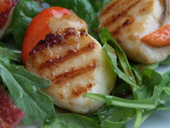
UK/Ireland
•Canada/USA
________________________________________________________________________

eat
scallops
Scallops are a seafood
like no other: mild, sweet-flavored morsels with a satisfyingly firm,
yet fine, texture.
They're great with robust flavors - try them with Oriental flavors such as ginger, chili or lemongrass (see PICK OF THE RECIPES).
HISTORY
Archaeological findings show that scallops have been eaten by humans for thousands of years, although until the advent of modern fishing techniques (scallops are usually found on seabeds) they formed a small part of the diet of opportunistic seaside foragers.
Today a number of species are found in waters around the world and scallops are esteemed in seafood-eating cultures everywhere
Throughout North America scallops are mostly harvested by dredging. Aquaculture production (scallop farming - common in China and Japan) is increasing as techniques and yields improve and wild stocks decline. There is also a growing market for hand-dived specimens.
BIOLOGY
Scallops (like mussels and oysters) are bivalve molluscs. They are found on sandy or muddy sea beds and feeds by filtering microscopic organisms from the surrounding sea water. Most scallops are hermaphrodites and spawn twice a year.
The edible part of the scallop is the pale adductor muscle and orange roe (coral). The muscle is used to rapidly open and close the scallop's two beautiful fan-shaped shells (as used in the Shell oil company's logo) enabling it to propel itself by expelling water.
NUTRITION
Scallops are rich in vitamin B12, calcium, iron, magnesium, potassium, zinc and copper. They are also an excellent source of protein, phosphorus and selenium.
TIPS
BUYING
Scallops are usually sold removed from their shells as, unlike mussels
or oysters, only part of the scallop is eaten. Look for plump, firm, moist
scallops with a sweet aroma. Some scallops are soaked in water; this increases
their weight but impairs flavor and texture. Unsoaked scallops should
be creamy or slightly off-white; soaking tends to produce overtly white
scallops.
Choose (pricier) hand-dived scallops if you want to support a more environmentally-friendly and sustainable fishing method; dredging tends to damage the sea bed.
STORING
Scallops are highly perishable and should be refrigerated as soon as possible
after purchase in an airtight container. They are best enjoyed the same
day but will keep for a couple of days. Scallops freeze fairly well -
this causes some loss of moisture and flavor but previously frozen scallops
are still excellent in soups or stews.
PREPARING
Cooking scallops to perfection takes some skill (or luck) as over-cooking
can quickly result in tough scallops. Scallops are cooked when the the
flesh is opaque and just firm. Slicing scallops into two thinner discs
can help by aiding uniform cooking and is recommended for particularly
big scallops.
OTHER STUFF
Scallop shells feature concentric rings. One ring forms each year, so the number of rings on the shell indicates the age of the scallop.
PICK OF THE RECIPES
in
season:
january
february
march
april
may
june
july
august
september
october
november
december
main regions:
Atlantic Coast
ONLINE
IN PRINT
-
Scallops with Pureed Shallots and Black-Pepper Tangerines
The Complete Cookery Year -
Angel Hair Pasta with Garlic, Scallops and Rocket
Bowl Food -
Scallops and Bacon
How to Eat: The Pleasures and Principles of Good Food


